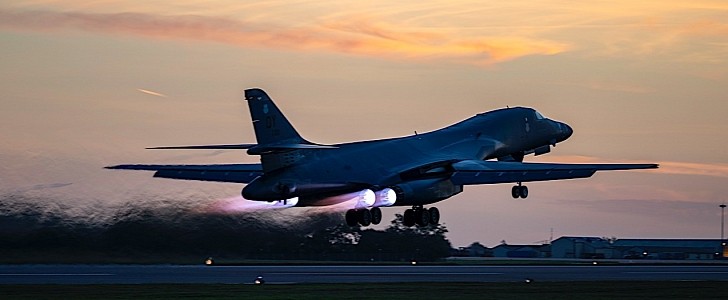Pilots call it The Bone, not because it looks like some anatomical part, but because people like to give meaning to otherwise seemingly random designations. Its official name is B-1 Lancer, and its trade is heavy bombing enemy positions.
The B-1 (aka B-One), like most other planes currently flying, is an old beast. It was born all the way back in the 1980s as a supersonic heavy bomber, capable of carrying 75,000 lbs (34,019 kg) of bombs in three internal bays.
Unlike some of the airplanes currently fielded by the U.S. Air Force (USAF), the B-1 had its share of fights. It was involved in conflicts in Syria, Libya, Afghanistan, and Iraq, but it gained notoriety after dropping 20 percent of all the bombs released over Yugoslavia in 1999, while flying just 2 percent of all missions.
At the moment, with America no longer involved in any major conflict, the B-1 has to contend with training missions. And it was exactly for such a mission a B-1B Lancer (the most recent variant) is flying off to in the photo we have here.
This particular plane is deployed with the 9th Expeditionary Bomb Squadron, usually stationed at the Dyess Air Force Base, Texas, and one of the oldest squadrons in the USAF – it was born all the way back in 1917 as a night reconnaissance unit.
Back in October, the squadron and its B-1s arrived at the RAF Fairford base in the UK for a Bomber Task Force training mission using the Agile Combat Employment principles. It was then that this photo of one of the monsters taking off was snapped.
It shows a B-1 departing the base’s runway, with all four of its General Electric turbofan engine burning hot at full throttle. For reference, each of the four powerplants is capable of delivering over 30,000 pounds of thrust with the afterburner on, and combined can push the airplane to a top speed of Mach 1.2 (921 mph/1,482 kph).
Bombers are not generally as advertised by the Air Force as say fighter jets and tankers, so this piece kind of helps us put the B-1 into perspective.
Unlike some of the airplanes currently fielded by the U.S. Air Force (USAF), the B-1 had its share of fights. It was involved in conflicts in Syria, Libya, Afghanistan, and Iraq, but it gained notoriety after dropping 20 percent of all the bombs released over Yugoslavia in 1999, while flying just 2 percent of all missions.
At the moment, with America no longer involved in any major conflict, the B-1 has to contend with training missions. And it was exactly for such a mission a B-1B Lancer (the most recent variant) is flying off to in the photo we have here.
This particular plane is deployed with the 9th Expeditionary Bomb Squadron, usually stationed at the Dyess Air Force Base, Texas, and one of the oldest squadrons in the USAF – it was born all the way back in 1917 as a night reconnaissance unit.
Back in October, the squadron and its B-1s arrived at the RAF Fairford base in the UK for a Bomber Task Force training mission using the Agile Combat Employment principles. It was then that this photo of one of the monsters taking off was snapped.
It shows a B-1 departing the base’s runway, with all four of its General Electric turbofan engine burning hot at full throttle. For reference, each of the four powerplants is capable of delivering over 30,000 pounds of thrust with the afterburner on, and combined can push the airplane to a top speed of Mach 1.2 (921 mph/1,482 kph).
Bombers are not generally as advertised by the Air Force as say fighter jets and tankers, so this piece kind of helps us put the B-1 into perspective.










